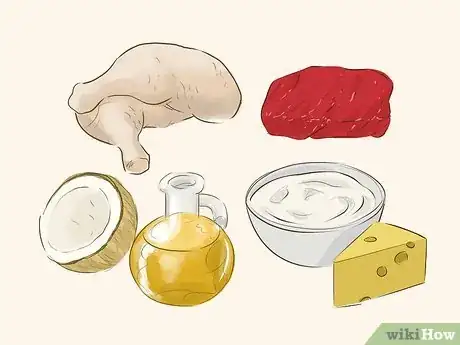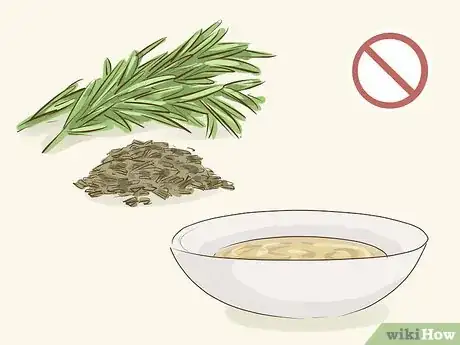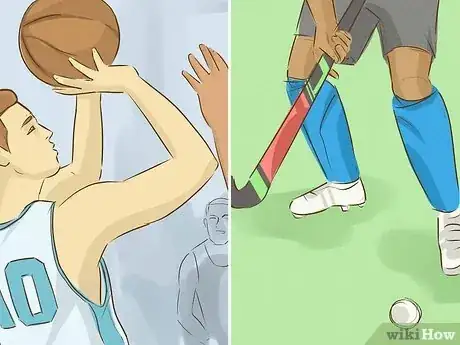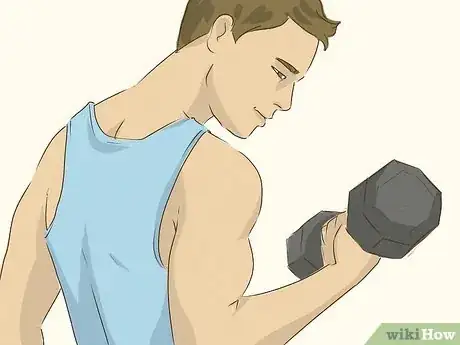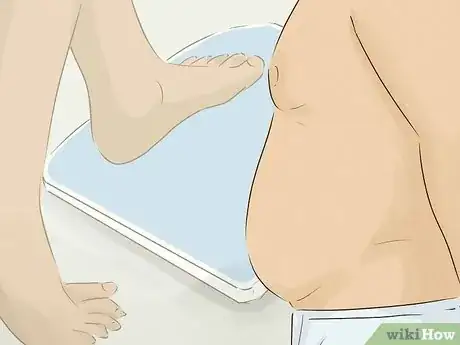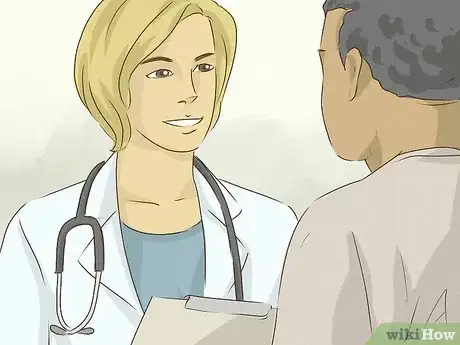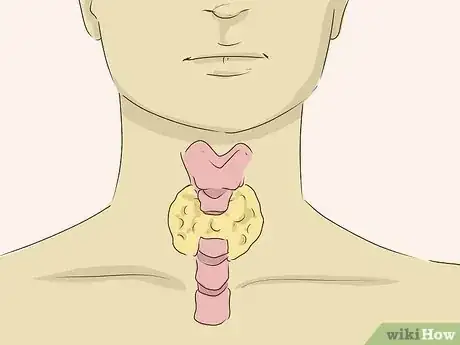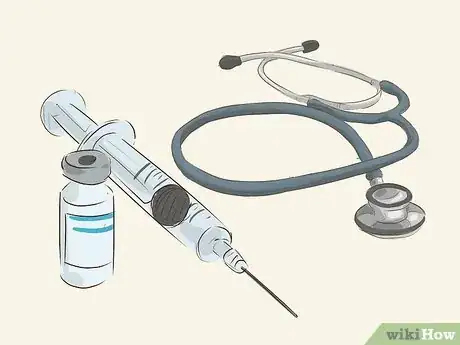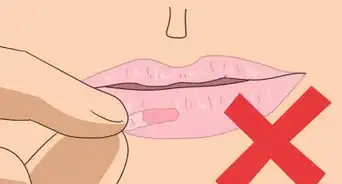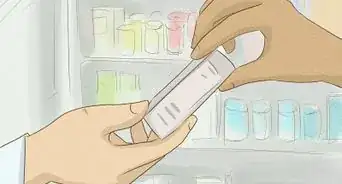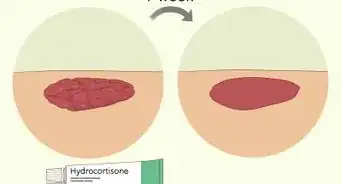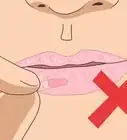This article was co-authored by wikiHow Staff. Our trained team of editors and researchers validate articles for accuracy and comprehensiveness. wikiHow's Content Management Team carefully monitors the work from our editorial staff to ensure that each article is backed by trusted research and meets our high quality standards.
There are 17 references cited in this article, which can be found at the bottom of the page.
This article has been viewed 19,497 times.
Androgen receptors are responsible for transmitting hormones, such as testosterone. If you don’t have enough androgen receptors, you might find it harder to build muscle or lose weight. Luckily, there are some strategies you can try to boost the number of androgen receptors in your body. Start by making some simple dietary changes and incorporating exercise, especially strength-training. If you’re still not getting the results you want, talk to your doctor. There might be an underlying cause that requires treatment.
Steps
Changing Your Diet
-
1Eat more peppers and other spicy foods. The capsaicin in peppers has been shown to increase androgen receptors, so don’t skimp on the spices when you’re cooking. Try choosing spicier versions of the foods you enjoy and adding peppers to other foods.[1]
- For example, if you normally get mild salsa, opt for medium or hot instead.
- If you make fajitas or tacos once per week, chop a jalapeno and add it to the onions while you sauté them.
-
2Drink a cup of coffee or tea each morning. The caffeine in coffee or tea may help to promote an increase in androgen receptors and testosterone, so try drinking a cup each day to see if it helps. Since caffeine is a stimulant, avoid drinking it within 3 hours of your bedtime.[2]
- As an added bonus, caffeine can help to boost your performance when you work out. Many athletic performance products, such as energy gels and energy drinks, contain caffeine for this reason.[3]
-
3Include a moderate amount of saturated fats in your diet. One study showed that saturated fats may help to promote an increase in androgen receptors while polyunsaturated fats, which are mainly found in vegetable oils, may decrease androgen receptors. Include 1 to 2 servings of a food that contains saturated fats to see if this helps boost your androgen receptors. Some good choices include:[4]
- Beef
- Pork
- Chicken with the skin on it
- Full fat cheese, yogurt, and milk
- Coconut oil
-
4Avoid foods that contain rosemary. The herb rosemary and rosemary extract may interfere with androgen receptors, so it’s best to avoid rosemary if you’re trying to increase your androgen receptor levels. It’s a common ingredient in Italian foods, so check labels of any processed foods you buy. Avoid adding the herb to any foods you cook as well.[5]
- Try using alternative herbs when a recipe calls for rosemary, such as basil, oregano, or thyme.
-
5Cut out any soy in your diet. Soy is known to increase estrogen which can interfere with androgen receptors and lower testosterone. Skip products that contain soy while you are working on increasing your androgen receptors. Soy is a common ingredient in many foods, so read labels to check for it. Some foods to avoid include:[6]
- Tofu
- Tempeh
- Soy milk
- Soy-based cheese, yogurt, and ice cream
- Protein powders and bars that contain soy protein
-
6Take a daily multivitamin that contains selenium. Selenium has been shown to have a positive effect on androgen receptors, so including a daily multivitamin that contains your daily recommended allowance of selenium may be helpful. Do not exceed the recommended daily allowance of selenium as this will not increase the benefit.[7]
- Adults require 55 micrograms of selenium daily.
- You can also get selenium by eating certain foods, such as brazil nuts, tuna, halibut, and ham.[8]
Tip: Taking a daily multivitamin may help to provide nutritional insurance if you don’t always eat a balanced diet. However, try to choose healthy foods to ensure that you are also consuming a good balance of macronutrients, such as protein, carbohydrates, and fats.
Exercising and Losing Weight
-
1Engage in competitive sports for cardiovascular exercise. There is some evidence that being in competition with others and winning in sports can help to promote an increase in androgen receptors. If you generally do solo or non-competitive exercises, consider joining a local intramural sports team or club.[9]
- For example, you might try joining a local basketball team, hockey team, or runner’s club depending on what you enjoy.
Tip: It’s recommended that you get 150 minutes of moderate cardiovascular exercise or 75 minutes of vigorous cardiovascular exercise every week.[10] Joining a sports team or club may help make it easier to meet this goal.
-
2Perform strength training 2 or more times per week. Lifting weights can help to promote an increase in your androgen receptors and raise your testosterone levels. If you don’t strength-train, incorporate a few resistance exercises into 2 of your weekly workouts. Go slow and don’t lift heavier weights than you can handle. Start out with a pair of 5 lb (2.3 kg) dumbbells and increase the weight as you gain strength. [11]
- You could also try doing resistance band exercises to build strength and then move on to lifting weights when you feel ready.
- Bodyweight exercises can also help you to build strength, such as pushups and sit ups.
-
3Have a snack or a meal after your workouts. Eating after you work out may also help to increase your androgen receptors. As soon as you get home from the gym, make yourself something healthy to eat. Opt for something that includes lean protein and a serving of fruit or veggies.[12]
- For example, have a turkey sandwich on whole wheat bread with carrot sticks as a post-workout meal, or a cup of Greek yogurt with an apple as a post workout snack.
-
4Make weight loss your goal if you’re obese or overweight. Being overweight or obese may reduce your androgen receptors and lower your testosterone, so increasing your androgen receptors may require losing weight first. Follow a healthy diet, exercise regularly, and set realistic goals for yourself to start losing weight.[13]
- Talk with your doctor if you’re unsure about how much weight to lose or if you’re struggling to lose weight.
Getting Medical Help
-
1Work with your doctor to increase your testosterone if it’s low. In some cases, your androgen receptors might not be something you can control on you own. You might need to seek help from a doctor to increase your androgen receptors and raise your testosterone levels. If nothing seems to help, see a doctor for treatment.[14]
- For example, you may require testosterone replacement therapy to increase your levels.
- Take any medications your doctor prescribes exactly as indicated.
Warning: If you are worried that your testosterone is low due to a lack of androgen receptors, do not try to self-treat it. See a doctor for help.
-
2Get checked for hypothyroidism. Hypothyroidism can decrease androgen receptors and lower testosterone levels. If you’re experiencing any symptoms of hypothyroidism, see your doctor for a diagnosis and treatment.[15] Some common symptoms of hypothyroidism include:[16]
- Fatigue
- Weight gain
- Constipation
- Dry skin
- Hair loss
- Impaired memory
- Sensitivity to cold
-
3Seek treatment for any underlying conditions. Certain health conditions may contribute to reduced androgen receptors. If you’re worried something might be interfering with your ability to gain muscle or lose weight, see your doctor. Some conditions that you may need to seek treatment for include:[17]
- Androgen insensitivity syndrome
- Spinal and bulbar muscular atrophy
- Polycystic ovary syndrome
- Androgenetic alopecia
- Prostate cancer
References
- ↑ https://www.sciencedirect.com/science/article/pii/S0014579308009502
- ↑ https://www.ncbi.nlm.nih.gov/pubmed/23136995
- ↑ https://www.ncbi.nlm.nih.gov/pubmed/11583104
- ↑ https://www.ncbi.nlm.nih.gov/pubmed/3260860
- ↑ https://journals.plos.org/plosone/article?id=10.1371/journal.pone.0089772
- ↑ https://www.ncbi.nlm.nih.gov/pubmed/17585029
- ↑ https://www.ncbi.nlm.nih.gov/pubmed/16648561
- ↑ https://ods.od.nih.gov/factsheets/Selenium-HealthProfessional/
- ↑ https://www.ncbi.nlm.nih.gov/pmc/articles/PMC4213638/
- ↑ https://medlineplus.gov/howmuchexercisedoineed.html
- ↑ https://www.ncbi.nlm.nih.gov/pubmed/15354030
- ↑ https://www.ncbi.nlm.nih.gov/pubmed/16826026
- ↑ https://diabetes.diabetesjournals.org/content/63/10/3180
- ↑ https://www.ncbi.nlm.nih.gov/pubmed/8625915
- ↑ https://www.ncbi.nlm.nih.gov/pubmed/8568470
- ↑ https://www.mayoclinic.org/diseases-conditions/hypothyroidism/symptoms-causes/syc-20350284
- ↑ https://ghr.nlm.nih.gov/gene/AR#conditions


